How to save money on your gardening
If you’re trying to save money on gardening, you need practical tips that work in real gardens. And you still want a beautiful garden.
So I’ve worked with self-sufficiency expert Liz Zorab, author of ‘Grounded’ and the Byther Farm YouTube channel to bring you the best tips.
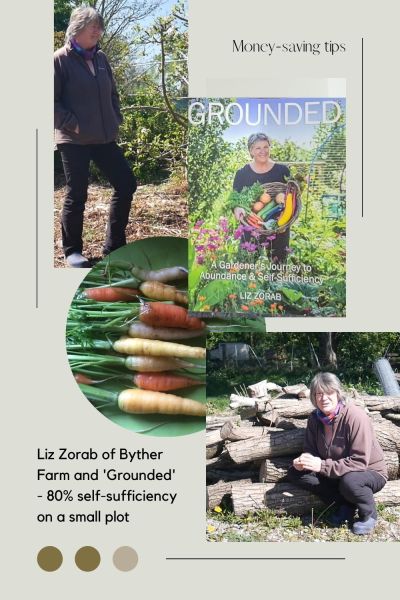
Plan ahead before you go shopping
This is particularly important for herbaceous borders and pots. It’s so easy to fall in love with what’s looking most colourful at the garden centre.
You fill your trolley, sometimes even spending hundreds of pounds or dollars. And then a few weeks later, the colour in your garden is over. You have to replace the plants, spending the same amount again.
These plants are often annuals, otherwise known as ‘bedding plants’. The plant itself grows from seed, flowers, sets seed and dies, all within a year. But they usually only flower for a few weeks or months in that year, so if your borders are very reliant on annual bedding plants you will usually have to replace them at least once during the season. That’s when it gets expensive.
Instead, work out roughly how many plants you need for an area and give yourself some ideas about colours, shapes and a balance of perennials and shrubs to annual bedding plants. These posts on perennials made simple, how to plan a successful flower border and how to plant a border like a pro should help.
If you plan ahead, then your border will look better for longer. And you won’t have to buy so many more plants!
Here is a detailed breakdown on how much it costs to replant a border completely, showing where you can save the most money.

In professionally-run gardens, like this one at Doddington Place Gardens in Kent, borders are always carefully planned before any plants are bought.
Grow from seed – even just a tray on a windowsill
You can always save money on gardening by growing your plants from seed. A packet of seeds could give you twenty or thirty plants. Yet it only cost a few pounds or dollars.
But it’s tricky to grow masses of different flowers from seed if you don’t have a greenhouse, polytunnel or potting shed. However you can grow a few trays of seed on a windowsill.
In a small (or middle-sized) garden, I’d suggest using seed growing not just to save money, but to add colour and drama. Grow types or flowers you can’t easily buy in the shops, such as cerinthe.
Or find unusual colours of easy to grow flowers like antirrhinums or cosmos. And there are some dramatic plants you don’t often find in traditional bedding plant selections, such as amaranth. For tips on sowing seeds successfully, see flower grower Sue Oriel’s tips here.
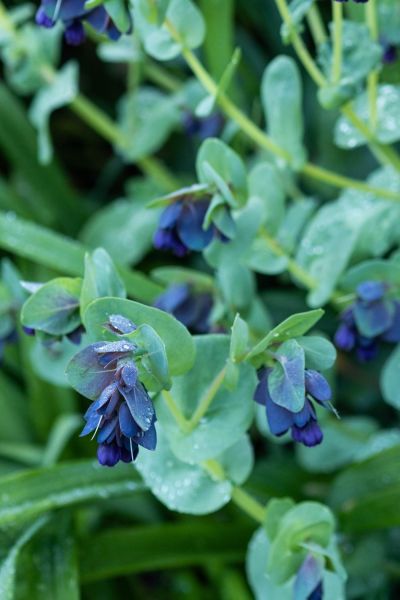
This is cerinthe. I grew some plants from seed around 10 years ago. Clumps of cerinthe have popped up around the garden ever since. They’re one of the earliest annuals to flower, often flowering from April to June.
If you grow plants that self seed well, then you’ll buy a packet of seeds one year. After the plants have flowered and set seed, they re-seed themselves in your borders, often coming back year after year. So those plants are absolutely free. Not all plants self-seed well but there’s a post here about using self-seeders to save you time and money in the garden.
Even with plants that self-seed, I find it’s better to sow the seeds in trays or modules first and then plant them out. If they’re going to self seed (and not all plants do), they’ll just get on with it in subsequent years. I’ve never had any luck with scattering seed in the soil myself.
Easy annuals that self seed in my garden include poppies, zinnias, nasturtiums, marigolds, amaranth, annual euphorbias and cerinthe.
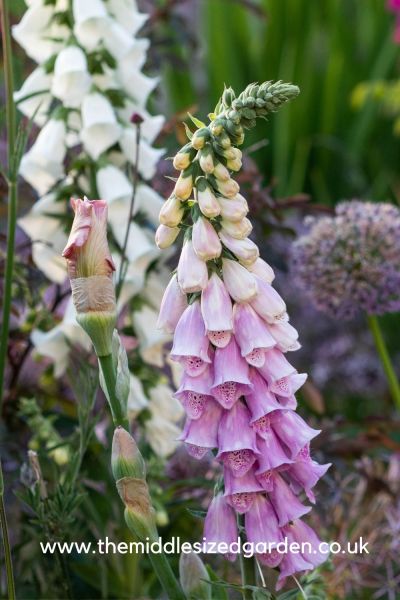
These foxgloves self seed around my garden, as do the alliums behind them. Plants for free!
You can also share seed packets with a friend. If you each plant just two kinds of flower seeds, you’ll have a great choice of flowers to fill gaps with.
Grow perennials – especially ones that spread
Perennials are plants that stay in ground over several years, so you won’t have to spend money (and time) replacing your plants once or twice a season. Some perennials spread easily. Every two or three years, you should dig them up and divide them, which creates more plants for free.
In my garden perennials that spread include day lilies and Japanese anemones. Like shrubs, some perennials are evergreen – I have some beautiful evergreen euphorbia wulfennii, otherwise known as Mediterranean spurge. Bergenia and Phlomis are also easy-grow spreading perennials which will add green to the garden all year round.
To find out more about choosing perennials, see Perennials Made Simple, with tips from Rosy Hardy.

Perennials like day lilies, crocosmia and euphorbia stay in the ground and spread over the years, filling your garden for free – or almost for free.
Other plants that spread include bulbs that naturalise well. If you look for ‘naturalises well’ on the label, then over the years, the bulbs will slowly spread over your garden. It does take time, though.
Save money when you buy bare root plants
It’s cheaper and more environmentally friendly to buy bare root hedging, roses and other shrubs. If you buy plants in containers, they’re labour intensive in the nursery, use a lot of water and are heavier to transport, so they cost more. Bare root plants are grown in fields so need less watering and are lighter to post or transport.
However bare root plants can only be planted when they are dormant. That’s between early autumn and mid spring. Container grown plants can be planted at any time of year.
Make your own plant supports
This advice came from Liz Zorab of the Byther Farm YouTube channel and blog.
Frustrated with thin wire supports that flop over when plants get too big and wanting to avoid the high priced steel plant supports, she made homemade supports. She used leftover industrial wire. That includes pig wire.
Pig wire or hog wire is used for fencing off areas used by pigs. It has a bigger mesh than, for example, chicken wire, so leaves and flowers can grow through it. Liz cuts it to fit and then uses wire to tie it into a semi-circle. She puts it over the plant before it’s grown too big, and secures it with bamboo canes.
Liz shows you how in our video on saving money in the garden. If you want to skip straight to how to make a plant support out of pig wire, it’s at 6 minutes 59 seconds. Or you can look in the description below the video and you’ll see time stamps. These are highlighted times. Click on them to go straight to the part of the video you want to see. And do go over to Liz’s channel for tips on saving money in the veg garden.
Sources of free or cheap garden tools
If you want to find garden tools for free, you may be lucky on the recycling and swapping sites, such as Freecycle and freegle . And you can usually buy second hand tools on local social media groups, such as Facebook Marketplace, eBay or in local markets and second-hand shops. But second hand tools won’t necessarily be good tools or in good condition.
However, I think it can be better to buy a few good quality tools new. The saying ‘buy cheap and buy twice’ applies to garden tools in particular. I belong to a few professional gardening Facebook pages, where people often ask others for their recommendations on tools. I’ve often seen praise for Showa gardening gloves and Felco or Niwaki secateurs and pruning tools. They’re actually the brands I use, and my Felco secateurs are now over 30 years old.
Note that links to Amazon are affiliate, see disclosure. I may get a small fee if you buy, but it doesn’t affect the price you pay. And I only recommend products I use myself or which have been recommended by sources I trust.
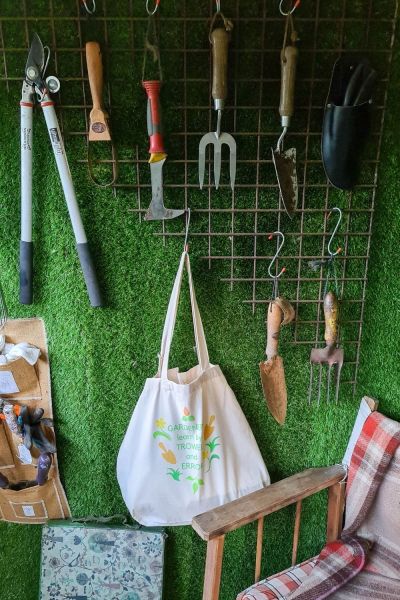
I believe that it’s worth spending money on good tools, although you can also buy tools second hand in markets and online.
You can also use the free and second sites for other things, such as garden furniture or manure. I have used freegle in the past to find a local farmer who allows people to take manure away for free. This isn’t practical if you live in a city, of course. And you need to be able to transport the manure, which won’t be in bags.
More money-saving garden ideas…
Join a local gardening club – they’re usually very good value for money. They often club together to get discounts with seed companies or they organise seed and plant swaps. And they’re a great source of expertise, as more experienced gardeners share their advice with newbies, and they organise talks and shows.
Use upcycled or recycled items as pots or ornaments. There’s a delightful post here with 10 charming small garden ideas on a budget.
And if you’re planning a big re-design, see this post on how to save money on garden design.
If you’re not sure whether to buy a new shed or renovate the old one, read this before buying a new shed. I particularly like stylist and writer Francine Raymond’s tips for turning a garage into a garden room here.
Get free or inexpensive advice
For example, the Royal Horticultural Society website is one of my go-to places if I want advice on a specific plant.
You can also buy gardening books second hand in bookshops and charity shops, but be aware that gardening techniques do change over the years. Gardeners today now tolerate more insects and pests and minimise the use of chemicals. Many jobs are done differently or not at all.
Blogs and YouTube videos are a good source of free advice. And on YouTube, you can see how people do things close up, which is a huge bonus. Institutions will give you the instructions on, say, how to move a tree fern. But the blog or YouTube channel will often tell you how an ordinary, non-expert person does it. My video on how to move a tree fern does really show the reality of it.
For tips, ideas and inspiration for gardens under an acre, see The Middlesized Garden YouTube channel. And for veg growing, self-sufficiency and homesteading tips, see Liz Zorab at Byther Farm.
Money saving gardening tips that don’t always work!
Many famous gardening money saving tips or ‘hacks’ don’t always work. Although do say if you disagree!
There’s debate over the use of vinegar as a weed-killer, for example. Some studies show that you need a super strength vinegar, which can be dangerous to use. Certainly, you must use full strength vinegar. If it’s ordinary household vinegar, several applications will be needed, even at full strength.
One university study showed that because of the strength of the vinegar and the need for repeated applications, it was no cheaper than using commercial weed-killers.
The cheapest way of dealing with weeds is to hand weed. That’s also the safest and most environmentally friendly way.
Does making your own compost save money?
Making your own compost will save you some money. It’s a convenient way of disposing of garden waste. And it returns the goodness to the soil. Your plants will love your homemade garden compost.
But it’s difficult for any garden to make all the compost it needs. Garden clippings and kitchen scraps rot down to a fraction of their volume.
I’ve done some calculations. I have three compost bins and a garden that is 100ft long, 80ft wide at its widest and 40ft wide nearer the house. Making my own garden compost is very useful and saves me about £100 a year. But it’s not enough. I still have to spend about twice that a year on well rotted manure or mushroom compost.
And one small compost bin won’t even achieve those savings. It’s still a good thing to do, though.
And can you save money by getting a water butt?
The same applies to installing a small or standard water butt. It’s good to have a water butt connected to the guttering of your garden shed or house roof. Some plants and all ponds prefer rainwater.
But one standard-sized water butt will only provide a few days of water when the weather is very dry. So it won’t save you much money if you are metered.
Get the largest water butt you can fit into your garden. It’s even better to join two or three together. That will give you a reasonable amount of water. But you’ll probably still need to use tap water after about 10-14 days of drought, depending on how water dependent your garden is.
Plant for the rainfall you have – if you have dry summers, plant drought-resistant plants. And make sure that there is access for a hose, especially in the veg garden.
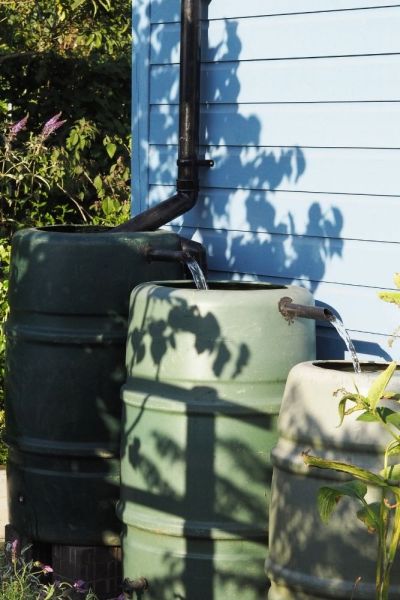
Three different sizes of water butt connected up. They’ll be much more useful than one in dry weather.
Shop my favourite gardening books, tools and products
I’m often asked for recommendations so I’ve got some lists of the garden tools, books and products I use myself on the Middlesized Garden Amazon store. For example, there’s a list of essential garden tools and also my pick of wildlife friendly gardening books.
Pin to remember money-saving gardening tips
And if you’d like more tips, ideas and inspiration for your garden, see here to get the Middlesized Garden straight to your inbox once a week (it’s free!)
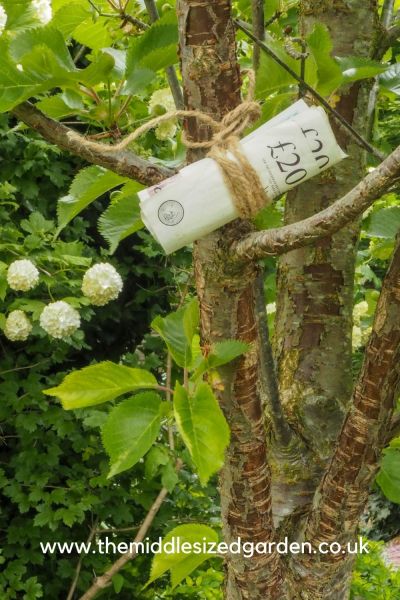
























Love your article and money saving tips. I have a small patio area so can only grow in containers. I’m currently growing some herbs, salads and carrots in container and decided this year would look into growing some flowers.
I thought your tip for self seed plants are brilliant but wondering if it would work for container gardening?
Thank you. I do have some plants that self seed in pots sometimes, but it’s very random. I think probably it’s best to decide what you want in your pots and plant them.
Enjoyed your gardening tips .looking forwards to using some in my little walled garden .Thank you
Thank you!
Looks interesting and helpful
Thank you!
Have you any idea why my composting bin attracted rats?-nobody else seems to have this problem.I no longer use it as,I absolutely hate rats.
It is quite a common problem, I’m afraid. The basic steps are never to put any kind of cooked food or raw meat or fish in. Other preventative measures include leaving the top off so that the compost gets wet in the rain (it doesn’t seem to harm the compost), stirring it regularly and also giving the bin a bang with a fork or spade when you pass. All these make it much less cosy for rats. But I sympathise, it’s a horrible problem.